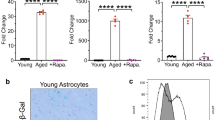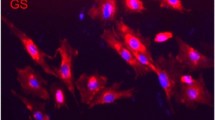Abstract
When retinal cell cultures were mechanically scratched, cell growth over the empty area was observed. Only dividing and migrating, 2 M6-positive glial cells were detected. Incubation of cultures with apyrase (APY), suramin, or Reactive Blue 2 (RB-2), but not MRS 2179, significantly attenuated the growth of glial cells, suggesting that nucleotide receptors other than P2Y1 are involved in the growth of glial cells. UTPγS but not ADPβS antagonized apyrase-induced growth inhibition in scratched cultures, suggesting the participation of UTP-sensitive receptors. No decrease in proliferating cell nuclear antigen (PCNA+) cells was observed at the border of the scratch in apyrase-treated cultures, suggesting that glial proliferation was not affected. In apyrase-treated cultures, glial cytoplasm protrusions were smaller and unstable. Actin filaments were less organized and alfa-tubulin-labeled microtubules were mainly parallel to scratch. In contrast to control cultures, very few vinculin-labeled adhesion sites could be noticed in these cultures. Increased Akt and ERK phosphorylation was observed in UTP-treated cultures, effect that was inhibited by SRC inhibitor 1 and PI3K blocker LY294002. These inhibitors and the FAK inhibitor PF573228 also decreased glial growth over the scratch, suggesting participation of SRC, PI3K, and FAK in UTP-induced growth of glial cells in scratched cultures. RB-2 decreased dissociated glial cell attachment to fibronectin-coated dishes and migration through transwell membranes, suggesting that nucleotides regulated adhesion and migration of glial cells. In conclusion, mechanical scratch of retinal cell cultures induces growth of glial cells over the empty area through a mechanism that is dependent on activation of UTP-sensitive receptors, SRC, PI3K, and FAK.













Similar content being viewed by others
References
Adler R (2000) A model of retinal cell differentiation in the chick embryo. Prog Retin Eye Res 19(5):529–557
Sarthy V, Ripps H (2001) The retinal Müller cell - structure and function. Kluwer Academic / Plenum Publishers, New York
Reis RAM, Ventura ALM, Schitine CS, de Mello MC, de Mello FG (2008) Müller glia as an active compartment modulating nervous activity in the vertebrate retina: neurotransmitters and trophic factors. Neurochem Res 33:1466–1474
Bringmann A, Pannicke T, Grosche J, Francke M, Wiedemann P, Skatchkov SN, Osborne NN, Reichenbach A (2006) Müller cells in the healthy and diseased retina. Prog Retin Eye Res 25(4):397–424
Reichenbach A, Bringmann A (2013) New functions of Müller cells. Glia 61(5):651–678
Martins RA, Pearson RA (2008) Control of cell proliferation by neurotransmitters in the developing vertebrate retina. Brain Res 1192:37–60
Bringmann A, Wiederman P (2011) Müller glia cells in retinal disease. Ophthalmologica 227(1):1–19
Dyer MA, Cepko CL (2001) Regulating proliferation during retinal development. Nat Rev Neurosci 2:333–342
Perez MT, Ehinger BE, Lindström K, Fredholm BB (1986) Release of endogenous and radioactive purines from the rabbit retina. Brain Res 398(1):106–112
Santos PF, Caramelo OL, Carvalho AP, Duarte CB (1999) Characterization of ATP release from cultures enriched in cholinergic amacrine-like neurons. J Neurobiol 41(3):340–348
Newman EA (2005) Calcium increases in retinal glial cells evoked by light-induced neuronal activity. J Neurosci 25(23):5502–5510
Loiola EC, Ventura ALM (2011) Release of ATP from avian Müller glia cell in culture. Neurochem Int 58:414–422
Pearson RA, Dale N, Llaudet E, Mobbs P (2005) ATP released via gap junction hemichannels from the pigment epithelium regulates neural retinal progenitor proliferation. Neuron 46(5):731–744
Reigada D, Lu W, Mitchell CH (2006) Glutamate acts at NMDA receptors on fresh bovine and on cultured human retinal pigment epithelial cells to trigger release of ATP. J Physiol 575:707–720
Costa G, Pereira T, Neto AM, Cristóvão AJ, Ambrósio AF, Santos PF (2009) High glucose changes extracellular adenosine triphosphate levels in rat retinal cultures. J Neurosci Res 87:1375–1380
Resta V, Novelli E, Vozzi G, Scarpa C, Caleo M, Ahluwalia A, Solini A, Santini E, Parisi V, Di Virgilio F, Galli-Resta L (2007) Acute retinal ganglion cell injury caused by intraocular pressure spikes is mediated by endogenous extracellular ATP. Eur J Neurosci 25:2741–2754
Wurm A, Pannicke T, Iandiev I, Francke M, Hollborn M, Wiedemann P, Reichenbach A, Osborne NN, Bringmann A (2011) Purinergic signaling involved in Müller cell function in the mammalian retina. Prog Retin Eye Res 30:324–342
Guzman-Aranguez A, Santano C, Martin-Gil A, Fonseca B, Pintor J (2013) Nucleotides in the eye: focus on functional aspects and therapeutic perspectives. J Pharmacol Exp Ther 345:331–341
Housley GD, Bringmann A, Reichenbach A (2009) Purinergic signaling in special senses. Trends Neurosci 32(3):128–141
Sanches G, Alencar LS, Ventura ALM (2002) ATP induces proliferation of retinal cells in culture via activation of PKC and extracellular signal-regulated kinase cascade. Int J Dev Neurosci 20(1):21–27
França GR, Freitas RCC, Ventura ALM (2007) ATP-induced proliferation of developing retinal cells: regulation by factors released from postmitotic cells in culture. Int J Dev Neurosci 25(5):283–291
Wurm A, Erdmann I, Bringmann A, Reichenbach A, Pannicke T (2009) Expression and function of P2Y receptors on Müller cells of the postnatal rat retina. Glia 57:1680–1690
Sholl-Franco A, Fragel-Madeira L, Macama AC, Linden R, Ventura ALM (2010) ATP controls cell cycle and induces proliferation in the mouse developing retina. Inl J Dev Neurosci 28(1):63–73
Nunes PHC, Calaza KC, Albuquerque LM, Fragel-Madeira L, Sholl-Franco A, Ventura ALM (2007) Signal transduction pathways associated with ATP-induced proliferation of cell progenitors in the intact embryonic retina. Int J Dev Neurosci 25:499–508
Ornelas IM, Ventura ALM (2010) Involvement of the PI3K/Akt pathway in ATP-induced proliferation of developing retinal cells in culture. Int J Dev Neurosci 28(6):503–511
Ornelas IM, Martins Silva T, Ventura ALM (2013) PI3K/Akt pathway regulates mitotic progression of progenitor cells in the avian embryonic retina. PLoS ONE 8(1):e53517
Corriden R, Insel PA (2012) New insights regarding the regulation of chemotaxis by nucleotides, adenosine, and their receptors. Purinergic Signal 8:587–598
Striedinger K, Meda P, Scemes E (2007) Exocytosis of ATP from astrocyte progenitors modulates spontaneous Ca2+ oscillations and cell migration. Glia 55(6):652–662
Scemes E, Duval N, Meda P (2003) Reduced expression of P2Y1 receptors in Connexin43–null mice alters calcium signaling and migration of neural progenitor cells. J Neurosci 23(36):11444–11452
Grimm I, Ullsperger SN, Zimmermann H (2010) Nucleotides and epidermal growth factor induce parallel cytoskeletal rearrangements and migration in cultured adult murine neural stem cells. Acta Physiol 199:181–189
Gonçalves JC, Silveira AL, de Souza HD, Nery AA, Prado VF, Prado MA, Ulrich H, Araújo DA (2013) The monoterpene (-)-carvone: a novel agonist of TRPV1 channels. Cytometry A 83:212–219
Glaser T, de Oliveira SL, Cheffer A, Beco R, Martins P, Fornazari M, Lameu C, Junior HM, Coutinho-Silva R, Ulrich H (2014) Modulation of mouse embryonic stem cell proliferation and neural differentiation by the P2X7 receptor. PLoS One 9(5):e96281
Neary JT, Zhu Q, Kang Y, Dash PK (1996) Extracellular ATP induces formation of AP-1 complexes in astrocytes via P2 purinoceptors. Neuroreport 7:2893–2896
Rathbone MP, Middlemiss PJ, Gysbers JW, Andrew C, Herman MA, Reed JK, Ciccarelli R, Di Iorio P, Caciagli F (1999) Trophic effects of purines in neurons and glial cells. Prog Neurobiol 59:663–690
Neary JT, Kang Y, Shi YF (2005) Cell cycle regulation of astrocytes by extracellular nucleotides and fibroblast growth factor-2. Purinergic Signal 1(4):329–336
Liu J, Liao Z, Camden J, Griffin KD, Garrad RC, Santiago-Pérez LI, González FA, Seye CI, Weisman GA, Erb L (2004) Src homology 3 binding sites in the P2Y2 nucleotide receptor interact with Src and regulate activities of Src, proline-rich tyrosine kinase 2, and growth factor receptors. J Biol Chem 279(9):8212–8218
Wang M, Kong Q, Gonzalez FA, Sun G, Erb L, Seye C, Weisman GA (2005) P2Y nucleotide receptor interaction with alpha integrin mediates astrocyte migration. J Neurochem 95(3):630–640
Cárdenas A, Kong M, Alvarez A, Maldonado H, Leyton L (2014) Signaling pathways in neuron-astrocyte adhesion and migration. Curr Mol Med 14:275–290
Fischer AJ, Mcguire CR, Dierks BD, Reh TA (2002) Insulin and fibroblast growth factor 2 activate a neurogenic program in Müller glia of the chicken retina. J Neurosci 22:9387–9398
Close JL, Liu J, Gumuscu B, Reh TA (2006) Epidermal growth factor receptor expression regulates proliferation in the postnatal rat retina. GLIA 54:94–104
Dupin I, Camand E, Etienne-Manneville S (2009) Classical cadherins control nucleus and centrosome position and cell polarity. J Cell Biol 185(5):779–786
Tran MD, Wanner IB, Neary JT (2008) Purinergic receptor signaling regulates N-cadherin expression in primary astrocyte cultures. J Neurochem 105:272–286
Martiáñez T, Lamarca A, Casals N, Gella A (2013) N-cadherin expression is regulated by UTP in schwannoma cells. Purinergic Signal 9(2):259–270
Chaulet H, Desgranges C, Renault MA, Dupuch F, Ezan G, Peiretti F, Loirand G, Pacaud P, Gadeau AP (2001) Extracellular nucleotides induce arterial smooth muscle cell migration via osteopontin. Circ Res 89:772–778
Acknowledgments
We would like to thank Maria Leite Eduardo and Sarah A. Rodrigues for technical assistance. This work was supported by grants from Fundação Carlos Chagas Filho de Amparo à Pesquisa do Estado do Rio de Janeiro (FAPERJ), Coordenação de Aperfeiçoamento de Pessoal do Ensino Superior (CAPES), Conselho Nacional de Desenvolvimento Científico e Tecnológico (CNPq) and Pró-reitoria de Pesquisa, Pós-graduação e Inovação (Proppi-UFF). I.M.O is the recipient of post-doctoral fellowship from PNPD-CAPES. Transitin (EAP3) and vinculin (VN 3-24) monoclonal antibodies developed respectively by G.J. Cole and Shinsuke Saga were obtained from the Developmental Studies Hybridoma Bank, created by the NICHD of the NIH and maintained at The University of Iowa, Department of Biology, Iowa City, IA 52242. H.U. acknowledges grant support from Fundação de Amparo à Pesquisa do Estado de São Paulo (FAPESP) and CNPq, Brazil.
Conflict of interest
I declare that all authors have no conflict of interest.
Author information
Authors and Affiliations
Corresponding author
Electronic supplementary material
Below is the link to the electronic supplementary material.
Glial cell division and migration in control scratched cultures. Cultures at E8C7 were scratched and after 3 days, medium was changed to MEM buffered with 25 mM HEPES (pH 7.4) plus serum and antibiotics and cultures mounted on a Leica SP5 confocal microscope. Time-lapse live imaging were performed by photographing cultures every 5 min during 6 h under differential interference contrast illumination using a 20x objective plus 1.5 x zoom. Bar = 75 μm. (MPG 2150 kb)
Online Resource 2
Effect of P2Y1 receptor antagonist and ADPβS on the incorporation of [ 3 H]-thymidine in retinal cell cultures. Retinal cultures were treated for 24 h with MRS2179 or ADPβS and the incorporation of [3H]-thymidine determined as described in the section of methods. (A) Retinal cultures at E7C1 were incubated with 500 μM ADP in the absence or presence of 5, 25 or 50 μM MRS 2179. (B) Retinal cultures at E8C8 that were scratched or not (control) were incubated with 50 μM ADPβS. Data represent the mean ± SEM of 3 to 5 independent experiments performed in duplicate. *** p < 0.001, compared to control cultures. ## p < 0.01 and ### p < 0.001, compared to ADP-treated cultures. (PPTX 67 kb)
Glial cell activity at the edge of the scratch in apyrase-treated cultures. Cultures at E8C7 were scratched and treated with 2.5 U/mL apyrase. After 3 days, medium was changed to MEM buffered with 25 mM HEPES (pH 7.4) plus apyrase, serum and antibiotics and cultures mounted on a Leica SP5 confocal microscope. Time-lapse live imaging were performed by photographing cultures every 5 min during ~8 h under differential interference contrast illumination using a 20x objective plus 1.5 x zoom. (MPG 3014 kb)
Rights and permissions
About this article
Cite this article
Silva, T.M., França, G.R., Ornelas, I.M. et al. Involvement of nucleotides in glial growth following scratch injury in avian retinal cell monolayer cultures. Purinergic Signalling 11, 183–201 (2015). https://doi.org/10.1007/s11302-015-9444-9
Received:
Accepted:
Published:
Issue Date:
DOI: https://doi.org/10.1007/s11302-015-9444-9




